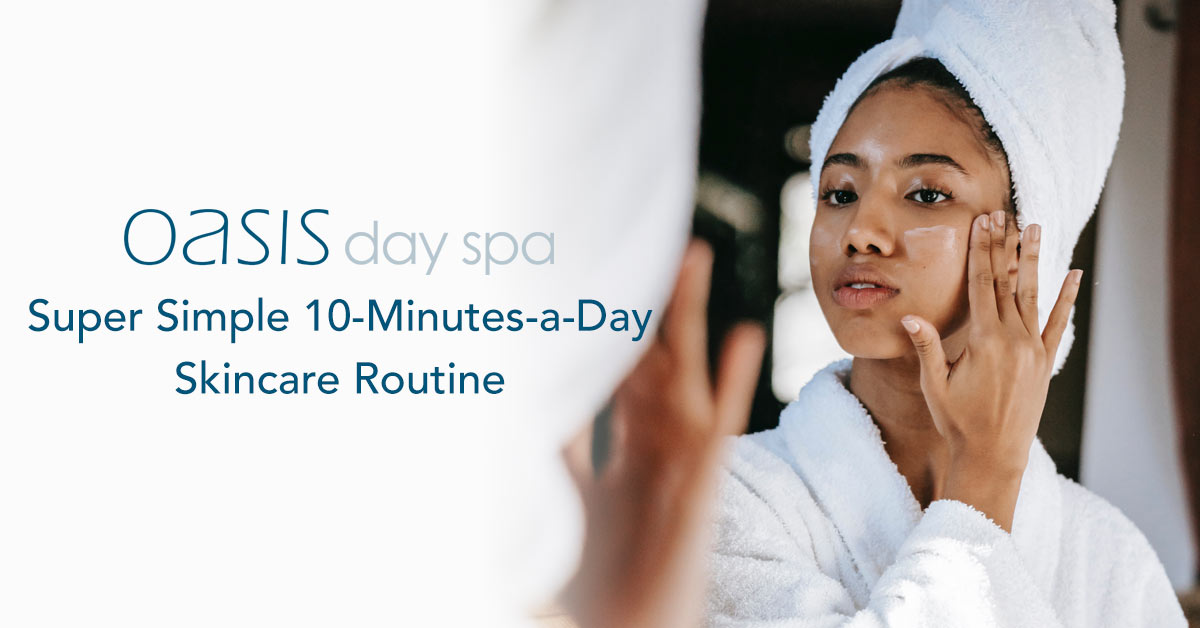
Super Simple 10-Minutes-a-Day Skincare Routine
While you can spend hours in the bathroom tending to your skin, you could actually do it in just ten minutes as well! Skincare revolves around consistency more than it does on doing everything you’ve ever watched on YouTube.
Speaking of consistency, having an established routine is substantially more beneficial for your skin health than anything else, and we want to help you find it with a few simple steps. So, without any further ado, let’s dive in:
One Minute for Exfoliation
Our skin is shedding dead cells in order to make way for new, healthy ones. These dead cells can pile up over time, even if we’re washing our face every morning, they tend to clog our pores and can make our skin dry and flaky.
Exfoliating is essentially the process of removing these piles of dead cells from the skin’s surface, opening our pores up, and allowing our skin to breathe.
Numerous studies have proved that exfoliation can also boost collagen production; collagen helps our skin be more elastic and flexible, which minimizes wrinkles.
There are two options for exfoliation – chemical and physical. Chemical exfoliating solutions use acids/enzymes to breakdown and dissolve dead skin cells rather than scrubbing them off. Commonly used ingredients include lactic, salicylic, or glycolic acids and fruit enzymes.
Physical exfoliants usually contain ground seeds, nuts, or grains that scrub off congestion from the surface as it is worked onto the skin. Speaking of which, numerous household products can be used as exfoliators, such as coffee grounds, oatmeal, baking soda, brown sugar, and sea salt.
Those with sensitive skin may opt for a gentle, cream, or gel enzyme product to avoid irritation from over scrubbing with a physical exfoliant.
Three Minutes for Area-Specific Treatments
This particular step should be different for everyone. The area-specific treatment essentially relates to treating the parts of your face that you want to heal.
Acne
People who struggle with acne should use clarifying tonics and solutions; generally speaking, any cream that boasts antiseptic and anti-inflammatory properties can help you deal with this particular issue.
If you prefer a more natural way to clear your acne, willow bark, calendula, chamomile, and lavender can help you greatly.
Probiotics are equally efficient. Lactobacillus Acidophilus-based probiotics in particular are perfect for reducing acne.
Similar to acne, blackheads can be quite a nuisance that is best dealt with through exfoliation. Toners and regular facial treatments are also great options for extracting blackheads.
Dry Skin
Moisturizing is generally the best way to deal with dry skin alongside a consistent exfoliating routine. However, sometimes the skin is so dry that it requires additional help.
Fortunately, there are numerous natural remedies that can help you tackle this issue, such as sunflower oil, coconut oil, oatmeal, milk, honey, and aloe vera.
Dark Circles Underneath the Eyes
Typically associated with dehydration and fatigue, dark circles are some of the hardest problems to deal with simply because they’re persistent and require consistent treatment.
Dark circles can be hereditary, but they can also be caused by allergies, eczema, hay fever, various pigmentation irregularities, and extensive sun exposure.
Eye creams work in most cases to hydrate and stimulate circulation to the area. Look for products with Vitamin E and K to nourish the delicate skin and stimulate circulation. A cold compress or eye mask can help soothe the area and constrict blood vessels to make the circles less visible in certain cases.
Sleeping, resting, and staying hydrated while eliminating potentially hazardous products from your facial treatments are the first steps towards the natural elimination of dark circles. Apply sunscreen daily even if you intend to spend most of the time under the shade.
Finally, stick to the same skincare routine. Your body will get accustomed to the ingredients of the products you’re using; your skin will gradually become healthier, and the dark circles will disappear after a while.
Two Minutes For Moisturizing
The moisturizing step is meant to hydrate and balance the skin. There are major differences between night and day moisturizers; day moisturizers are meant to protect the skin from dirt, pollution, ultraviolet rays, as well as environmental triggers while night moisturizers pack anti-aging compounds.
Natural ingredients to look out for in moisturizers include coconut oil, olive oil, and sunflower seed oil.
Four Minutes to Apply a Face Mask
Face masks are meant to address specific skin conditions and come in a variety of different textures. Face masks are also available in several formats – creams that are to be applied on the face just like any other lotion/cream, or peel-off masks with cut holes for eyes and mouth.
The benefits of face masks largely depend on their type; some of the most prominent benefits of skincare beauty masks include skin hydration, moisturization, unclogged pores, absorb excess dirt, debris, and oil, as well as enhanced skin elasticity.
Some of the popular types of face masks include clay, cream, gel, charcoal, and sleep masks. This categorization defines the texture and the feel of the masks while the ingredients define the potential benefits.
Peel-off masks can be put on and removed the fastest, although the process shouldn’t take more than four minutes for other mask types as well.
Purifying masks commonly use clays, mud, or charcoal to remove impurities, reduce acne bacteria, and control oiliness.
We hope that this guide was useful to you and that you’ve learned something new today on how to improve your daily skincare routine in a few simple steps!
